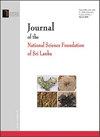Fluoride analysis in aqueous solutions - a comparison of two colorimetric methods
IF 0.4
4区 综合性期刊
Q4 MULTIDISCIPLINARY SCIENCES
Journal of the National Science Foundation of Sri Lanka
Pub Date : 2023-06-30
DOI:10.4038/jnsfsr.v51i2.10868
引用次数: 0
Abstract
Fluoride is beneficial for human health only in a narrow concentration range. Over the years, many analytical techniques have been developed to quantify fluoride in a variety of sample matrices. In this research, fluoride concentrations of twenty (20) natural water samples determined by SPADNS (SPA) and Eriochrome Cyanine R (ECR) colorimetric methods were evaluated to ascertain whether these methods can produce comparable fluoride concentrations. According to the paired t test for comparing individual differences, the two datasets are different at 95% confidence level suggesting that the two analytical methods produce statistically different fluoride concentrations for the analysed water samples. The potential interferences of Al3+, Ca2+, and Mg2+ on the fluoride analysis was evaluated using 0.85 mg L-1 fluoride standard solutions spiked with various amount of the above-mentioned metal ions. The highest interference was observed with Al3+ ions, which underestimated the fluoride concentration by 26% and 23% for ECR and SPA methods respectively at 20.0 mg L-1 Al3+ concentrations. The minimum interference was observed for Ca2+ ions which underestimated the fluoride concentration by 8% and 7% for ECR and SPA methods respectively at 100.0 mg L-1 Ca2+ concentrations. Acid distillation resulted in the samples spiked with Ca2+ and Mg2+ ions in the range of 0.50 to 100.0 mg L-1 reaching the theoretical concentration of 0.85 mg L-1. Acid distillation also worked well for the Al3+- fortified samples, except for Al3+ concentration at 20 mgL-1. The efficiency of the acid distillation method was also tested with three (03) natural water samples. The fluoride concentration increased significantly after the acid distillation; however, even after the acid distillation, statistically comparable fluoride concentrations were not observed.水溶液中氟化物的分析——两种比色法的比较
氟化物只有在很小的浓度范围内对人体健康有益。多年来,已经开发了许多分析技术来量化各种样品基质中的氟化物。在这项研究中,通过SPADNS(SPA)和Eriochrome Cyanine R(ECR)比色法测定了二十(20)个天然水样的氟化物浓度,以确定这些方法是否能产生类似的氟化物浓度。根据用于比较个体差异的配对t检验,这两个数据集在95%置信水平下是不同的,这表明这两种分析方法对所分析的水样产生了统计上不同的氟化物浓度。使用掺有不同量的上述金属离子的0.85 mg L-1氟化物标准溶液来评估Al3+、Ca2+和Mg2+对氟化物分析的潜在干扰。观察到Al3+离子的干扰最高,在20.0 mg L-1的Al3+浓度下,ECR和SPA方法分别低估了26%和23%的氟化物浓度。观察到Ca2+离子的干扰最小,在100.0mg L-1 Ca2+浓度下,ECR和SPA方法分别低估了8%和7%的氟化物浓度。酸蒸馏导致样品掺入0.50至100.0 mg L-1范围内的Ca2+和Mg2+离子,达到0.85 mg L-1的理论浓度。除Al3+浓度为20mgL-1外,酸蒸馏对Al3+强化样品也很有效。酸蒸馏方法的效率也用三(03)个天然水样进行了测试。酸蒸馏后氟化物浓度显著增加;然而,即使在酸蒸馏之后,也没有观察到统计上可比较的氟化物浓度。
本文章由计算机程序翻译,如有差异,请以英文原文为准。
求助全文
约1分钟内获得全文
求助全文
来源期刊

Journal of the National Science Foundation of Sri Lanka
MULTIDISCIPLINARY SCIENCES-
CiteScore
0.90
自引率
0.00%
发文量
57
审稿时长
>12 weeks
期刊介绍:
The Journal of National Science Foundation of Sri Lanka (JNSF) publishes the results of research in Science and Technology. The journal is released four times a year, in March, June, September and December. This journal contains Research Articles, Reviews, Research Communications and Correspondences.
Manuscripts submitted to the journal are accepted on the understanding that they will be reviewed prior to acceptance and that they have not been submitted for publication elsewhere.
 求助内容:
求助内容: 应助结果提醒方式:
应助结果提醒方式:


